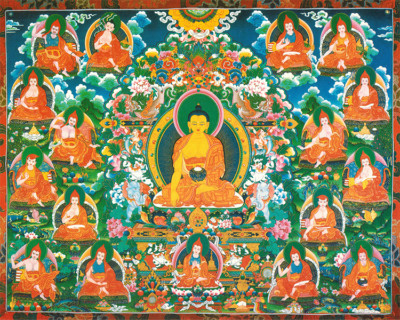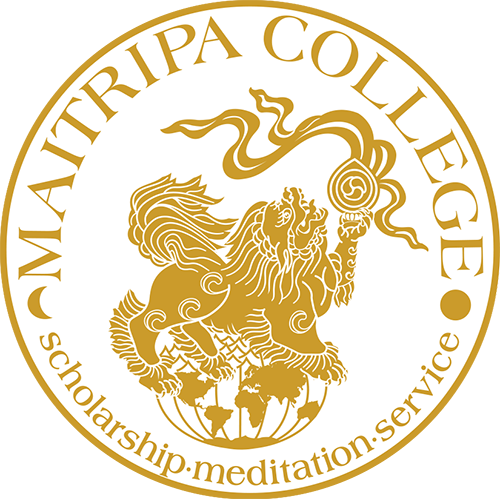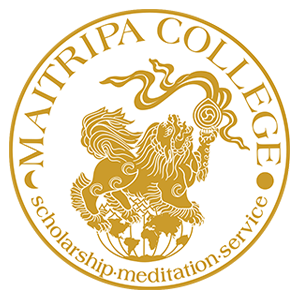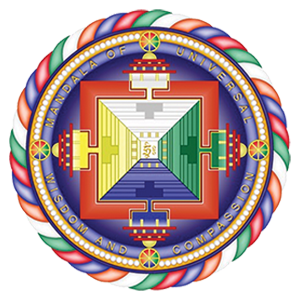Rigorous study has long occupied a central place in Buddhist life. Many traditions consider an accurate understanding of Buddha’s teachings to be indispensable to the attainment of the highest realization offered by the Buddhist path: enlightenment and liberation from all suffering. Sustained scholarship is also required to ensure that the teachings of the Buddha remain available for future generations. Both today and during the earlier history of Buddhism in India, Tibet, and elsewhere, monastic universities have served as key centers both for training serious practitioners and for preserving the teachings of the Buddha. This is Maitripa College’s Buddhist heritage and inspiration.
Two Great Indian Universities—Nalanda and Vikramashila
Nālandā
The monastic universities of Tibet follow a scholarly tradition with deep roots in India. The first such university in India was Nālandā, located in the present day state of Bihār and dating at least as far back as the fifth century CE. Nālandā was the site of the greatest flourishing of Indian Buddhist thought, and for centuries was home to generations of great masters, including Bhavaviveka and Chandrakīrti. Nālandā attracted students from abroad, who journeyed to this university to study with the approximately 1,500 teachers it was known to house at its peak. When the Chinese pilgrim Hsuan Tsang visited Nālandā in the mid-seventh century, he reported that 10,000 monks were in residence at the monastery. He wrote, “One must have studied deeply both the old and the new books before gaining admission. Those students, therefore, who come here as strangers have to show their ability by hard discussion. Seven to eight out of every ten fail.” As further witnessed by the texts composed by Chandrakīrti and others who studied there, it is evident that Nālandā was an extremely vibrant intellectual community to which Buddhist and non-Buddhist scholars alike traveled great distances to study and debate their views.
Vikramashīla
Another of the major monasteries of Buddhist India to leave a lasting impact on the Tibetan tradition was Vikramashīla. Vikramashīla was founded by the Pāla king Dharmapāla (775-810) in present day Bihār, and gained particular fame for its contributions to the study of Tantric Buddhism, as well as for being home to both Atisha (Dipamkara Shrījñāna, 981-1054) and to Naropa (the student of Tilopa and the teacher of Marpa). While the monastery at one time seems to have had 160 teachers and 1,000 students, by the time the Tibetan emissaries came to invite Atisha to Tibet in the 11th century, the monastery housed just 300 monks. After this time, Buddhism would soon disappear in India, even as Tibet’s importance as a center for monastic learning was mounting.
Inspiration: The Sixteen Arhats and the Seventeen Pandits of Nalanda Monastery
 The Sixteen Arhats or Sthaviras (Skt. Ṣoḍaśa Sthavirāḥ; Tib. གནས་བརྟན་བཅུ་དྲུག, Neten Chudruk; Wyl. gnas brtan bcu drug) were personally selected by Buddha Shakyamuni from among his disciples and requested by him to remain in the world, protecting the Dharma for as long as beings are capable of benefiting from the teachings. They vowed at the time of the parinirvana to remain in the world and maintain the Dharma until the time of the future Buddha Maitreya. It is taught that to visualize the Buddha Shakyamuni surrounded by the Sixteen Arhats and an assembly of bodhisattvas generates great merit and quickly develops insight into the teachings of the Buddha. Source: http://www.rigpawiki.org/index.php?title=Sixteen_Arhats. Click here for more, including text for the Sixteen Arhats Practice.
The Sixteen Arhats or Sthaviras (Skt. Ṣoḍaśa Sthavirāḥ; Tib. གནས་བརྟན་བཅུ་དྲུག, Neten Chudruk; Wyl. gnas brtan bcu drug) were personally selected by Buddha Shakyamuni from among his disciples and requested by him to remain in the world, protecting the Dharma for as long as beings are capable of benefiting from the teachings. They vowed at the time of the parinirvana to remain in the world and maintain the Dharma until the time of the future Buddha Maitreya. It is taught that to visualize the Buddha Shakyamuni surrounded by the Sixteen Arhats and an assembly of bodhisattvas generates great merit and quickly develops insight into the teachings of the Buddha. Source: http://www.rigpawiki.org/index.php?title=Sixteen_Arhats. Click here for more, including text for the Sixteen Arhats Practice.
The Seventeen Pandits of Nalanda Monastery refers to a grouping of seventeen of the most important and influential Mahayana Buddhist masters from India’s past. His Holiness the Dalai Lama frequently refers to himself as a follower of the lineage of the seventeen Nalanda masters today. Please click here for full explanation.
Major Monastic Universities in Tibet
Samye
The first monastery to house Tibetan monks was Samye (bsam yas), built in the late eighth century under the sponsorship of king Trisong Detsen (khri song sde btsan; 742-798). It was at Samye that the legendary debate between Kamalaśīla and the Chinese Ch’an monk Mohoyen took place, marking Tibet’s inclination toward Indian textual study, as opposed to Chinese-influenced meditative practices.
Sangpu
The first major center of philosophical studies in Tibet was the monastery of Sangpu, founded in 1073. Sangpu developed a focus on translating Sanskrit texts and on the study of Dharmakīrti’s epistemological treatises. It is here that such practices as debate, as well as the efforts to systematize the Indian texts, first entered the Tibetan scene. The tradition originating at Sangpu was so influential that it is sometimes pointed to as the beginning of Tibetan scholasticism.
Mindroling, Dorje Drag, and Kathog
The oldest of the six great Nyingma monastic universities, called Kathog, was founded in the year 1159. Other great monastic universities were built beginning in the 15th century in central Tibet, including the preeminent Nyingma monastic educational institution, Mindroling (smin grol gling), founded in 1676 by the Rigzin Terdag Lingpa (rig ‘dzin gter bdag gling pa), and Dorje Drag (rdo rje brag), founded in 1659. Unlike the later Gelug institutions, the Nyingma universities did not adopt a single standardized curricula. Rather, they tended to revolve around the study of a set of thirteen great texts, including Nagarjuna’s Mulamadhyamakakarika (Treatise on the Middle Way) and Candrakirti’s Madhyamakavatara (Introduction to the Middle Way).
Kagyü Lineages
While the Kagyü school was the first after the Nyingma to establish a monastery in Tibet – Reting was founded in 1056 CE – until the 20th century these monasteries were not configured as large centers for textual study in a way that can be described as “monastic universities.” With its divisions into multiple sub-sects and its many branch monasteries, the Kagyü lineage has tended to conduct its rigorous textual study on a smaller scale. However, an institution for scholarly study was founded in the mid-20th century in Pelpung (dpal spung) monastery in Kham, at the request of the 11th Tai Situ. Plans were underway to establish a similar center for study at the Karma Kagyü lineage’s seat, Tsurphu Monastery, but were halted by the communist invasion of Tibet in 1959.
Sakya
The Sakya school originated out of the lineage of the translator Drokmi (992-1072). The monastery of Sakya, from which the school takes its name, was founded in 1073. Initially, the Sakya center was a center for tantric practice open to monastics and lay students alike, and only gradually developed into a major scholastic center. It was largely under the influence of the great Sakya Pandita Kunga Gyaltsen (sa kya pandita kun dga’ rgyal mtshan, 1182-1251) that Sakya Monastery emerged as a major scholastic institution.
Sera, Drepung, and Ganden
Within the Gelug school tradition there are five central monasteries, the three largest of which are together known as the “Three Seats” (gdan sa sum). The earliest of these was Ganden (dga’ ldan), founded in 1409, and lending its name to the movement headed by Lama Tsongkhapa, whose followers were originally known as the Gandenpa, after the name of this first monastery. Drepung (‘bras spungs), the second of the three to be founded, was established in 1416 by Lama Tsongkhapa’s disciple Jamyang Chöje (‘jam dbyangs chos rje). The third seat to be built was Sera (se rwa), founded by Tsongkhapa’s disciple Jamchen Chöje (‘jam chen chos rje) in 1419. In Tibet, Sera and Drepung are both located within three miles of Lhasa. These ‘Three Seats’ were the largest monastic universities in Tibet, and very possibly the largest in the world. Prior to 1959, Ganden housed 7,000 monks, Drepung more than 13,000, and Sera 10,000.
Students at these Gelug monastic universities undergo a rigorous 20-year degree program, culminating in the rank of Geshe (dge bshes). The curriculum of these universities is distinguished amongst Tibetan scholastic centers by several notable features. Most prominent is the crucial role given to formal debate. Before 1959, monks at the three seats would debate as many as eight hours a day. Students were required to pass annual examinations, and were further tested at the conclusion of their course of study in public debates. Another distinctive feature of this curriculum was the relatively small number of texts it focuses upon: during the course of the entire 20-year curriculum only five root texts are studied.
In Exile: Tibetan Monastic Universities after 1959
During the time of the Chinese Cultural Revolution, many of the monasteries of all four schools of Tibetan Buddhism were destroyed. Those monastic universities that did survive continue today in Tibet in a greatly weakened form, lacking the political freedom and resources to approach anything like the level of scholastic training they had prior to the Chinese occupation. In exile, however, all four schools of Tibetan Buddhism have successfully recreated at least some of their monastic universities.
Sakya
The Sakya tradition has relocated its seat to Dehradun, India, where Sakya College continues the traditional Sakya curriculum, with courses of study lasting up to 13 years.
Kagyu
Rumtek monastery in Sikkim was founded in the early 1960s and offers training in the Karma Kagyü lineage.
Nyingma
Both the Nyingma and Gelug traditions have rebuilt their universities in South India. In Bylakuppe, the Nyingma scholastic center of Payül (one of the Six Great Nyingma Universities) has been rebuilt as Namdröling, and is today home to more than 2,000 monks. Furthermore, at the beginning of the 1970s, Penor Rinpoche founded a commentarial school (dshad brwa) within Namdröling, which now trains 400 students. The great Nyingma monastery of Mindröling was also rebuilt in Dehradun, beginning in 1965.
Gelug
All three of the “Three Seats” of the Gelug school have been rebuilt in South India. In the case of Sera, 200 monks from “Old Sera” re-established the university in Karnataka, India, after a decade of living in refugee camps. At present there are nearly 4,000 monks at Sera, and 2,000 each at Drepung and Ganden in India. While there have been many changes made to adapt to the new circumstances, the curriculum of the “Three Seats” remains remarkably similar to what it was in pre-1959 Tibet.
Institute of Buddhist Dialectics
There have also been many new scholastic centers founded in exile that have no precedent in Tibet. In 1973, the Institute of Buddhist Dialectics was founded in Dharamsala by His Holiness the Dalai Lama, and admits both lay and monastic students. The curriculum of the Institute of Buddhist Dialectics is closely modeled on the curriculum followed by the three major Gelug monastic universities. The same five texts are studied and debate remains a central component. However, the curriculum has been modified in anticipation of a new generation of Tibetans who have already finished high school, and are thus able to progress more quickly through the introductory levels of study. Notably, the Institute of Buddhist Dialectics differs from all other monastic universities discussed thus far in opening its doors to women, to whom no higher monastic education was made available in Tibet or India.
Central Institute of Higher Tibetan Studies
In 1967, the Central Institute of Higher Tibetan Studies was established in Sarnath, India, following joint discussions between Indian President Jawahar Lal Nehru and His Holiness the Dalai Lama. Initially operating under the auspices of the Sampurnananda Sanskrit University, Varanasi, the Central Institute was accredited as an independent university in 1988. The Central Institute offers advanced degrees to both lay and monastic students, after a nine-year course of study that includes debate but differs markedly from the curriculum of the other Tibetan institutions in combining Sanskrit and Tibetan studies, and in its inclusion of scholars from among the four different schools of Tibetan Buddhism.
Naropa University
Located in Boulder, Colorado, in the United States, Naropa University began in 1974 as a summer institute bringing together American Beat poets and the students of Chögyam Trungpa, a Tibetan Buddhist teacher in the Kagyü lineage. In 1986, the institution was accredited as a university, and today offers undergraduate degrees in childhood education, contemplative psychology, environmental studies, visual arts, writing and literature, and a number of other humanistic fields. While the university curriculum is not centered on the study of the major Indian philosophical texts—the traditional mainstay of monastic universities in Tibet and India—it does seek to incorporate Buddhist values and places a strong emphasis on meditative practice.
Kopan Monastery
Other new educational formats can be found among Tibetans in exile. Within the Gelug tradition, Kopan Monastery was founded in the Kathmandu valley of Nepal in 1969 by Lama Thubten Yeshe and Lama Thubten Zopa Rinpoche. Kopan is unique in that it continues the traditional Gelug scholastic curriculum, while also hosting regular meditation programs for Western students.
Lama Tzong Khapa Institute
Lama Thubten Yeshe also founded Lama Tzong Khapa Institute in Pomaia (Pisa) Italy in 1976. Lama Tzong Khapa Institute offers what is perhaps the most in-depth training in Buddhist philosophy currently available in the West.
Maitripa College
Based on our Buddhist heritage and the inspiration of the tradition of Buddhist Universities throughout history, Yangsi Rinpoche began teaching a four year Advanced Buddhist Studies Program at Maitripa Institute in Portland, Oregon in January, 2006. In July 2008, Maitripa Institute received legal authority to offer graduate degrees in Buddhist Studies in the state of Oregon. This approval means that Maitripa is now a College, and that the courses offered are available for college credit. Maitripa College is currently offering a Master of Arts degree in Buddhist Studies and a Master of Divinity degree. This achievement is the first step towards regional accreditation. We hope to expand these programs into a fully-functioning accredited university in the future, and to continue the precedent of great scholarship and practical application of this rich philosophical tradition in America.


